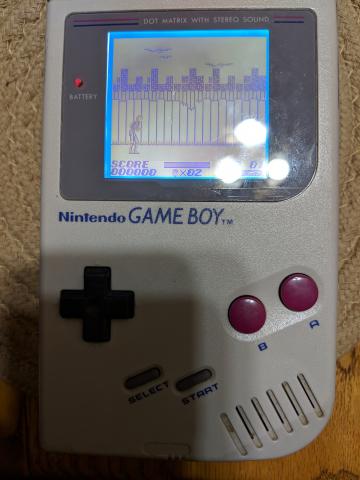
Game pictured is "The Amazing Spider-Man".
The Nintendo Game Boy took the world by storm, selling millions of units over its handful of iterations. The system was relatively inexpensive, portable, lasted quite a while on AA/AAA batteries, and had a large selection of games to choose from. Particularly with each successive generation being backwards compatible with previous generations. While a popular system, one major complaint was the lack of a lit LCD. Shockingly enough, it took all the way to the Game Boy Advance SP, released in 2003, to get a system in the US with a built in lighting solution. Albeit, a less than stellar solution, as it was a front-lit LCD. (Thankfully, two years later a backlit version of the SP was released that was superior.) After 14 years, no longer would you have to rely on a 3rd party lighting solution which usually resulted in glare on the screen.
I do realize there was an earlier Game Boy released with a backlight, the Game Boy Light. I do own one, and it works well. Yet, due to its exclusive release in Japan, low release numbers, and prohibitive cost now, I don't consider it a viable contender.
As the Game Boy Advance was backwards compatible with all Game Boy games, you could now play every game on a decent screen without worrying about lighting issues. This is certainly an option, but maybe you want to play on the original Game Boy. Or perhaps you have an old Game Boy gathering dust and would like to breathe some light into it. Enter the retro modding scene. People have created a variety of backlight and frontlight options for the Game Boy/Pocket/Color. I decided to give modding a Game Boy a try so I purchased a backlight and dusted off my Game Boy Original (DMG-01).
I purchased a white LED backlight and a bivert board from https://www.retrogaming.com, an online store based in Canada. Once the parts arrived I was able to do the install in a single evening. The install was quick and painless even though the bivert board requires two pins on the LCD connector to be de-soldered and bent up. The bivert board is not required but is recommended as it improves the contrast immensely on the original Game Boy.
Before installing the backlight, I attempted to mod it a little bit to see if I could get some additional brightness out of it. I removed the back panel and placed some ESR (enhanced specular reflector) film on the backlight. I am not sure if it made a difference. I will have to do a side by side comparison someday, which I plan to do as I have a Game Boy Pocket I would like to mod as well.
In conclusion, this is an excellent mod that I recommend you do. It is easy even for beginner solders, whether you want to add the bivert chip or not. This mod breathes some new life into the hardware, and a bit more enjoyment into those old games.
